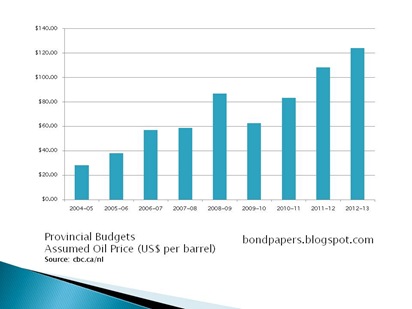The provincial government set its budget this year based on an oil price forecast of US$124 a barrel in 2012.
As we move up on the midway point in the fiscal year (it starts on April 1), oil is well below that. The result is that the provincial government could wind up with a deficit of nearly three quarters of a billion dollars, according to the Premier.
Some people are amazed by this.
They shouldn’t be.
This fits a pattern.
For starters, we need to establish a few things so that we are all on the same page.
First, the provincial government is heavily dependent on oil revenues. They make up 30% of its annual revenue.
Second, the current provincial administration has admitted to gross fiscal mismanagement by spending way beyond the limits of what they can sustain.
They compounded that error – acknowledged since 2009 – by continuing to spend beyond our collective means. Sure Premier Kathy Dunderdale admitted to unsustainable spending. She’s talked about fixing the problem. Thing is, she didn’t do anything about it.
Third, Kathy Dunderdale appointed the finance minister during the fiscal mismanagement to continue in the job.
Fourth, oil revenue is a function of annual oil production and the price per barrel of oil. How much you get depends on how much oil you produce and how much you sell it for.
Oil production in Newfoundland and Labrador peaked in 2007 with the second highest year being 2008. This chart from the provincial government’s economics division shows it quite nicely.
Compare that to the price of oil the provincial government has used each year to come up with its oil revenue number for the annual budget.
Don’t look at 2007.
Look at 2008.
Before the recession hit and when some oil forecasts were showing US$200 a barrel before the end of the year, the provincial government said oil would average US$86.87 a barrel. Newfoundland and Labrador’s number wasn’t wildly out of whack with what other jurisdictions – states, provinces and countries – used for oil
Oil production forecasts didn’t have oil output dropping by any great amount in 2008. By contrast, though, provincial forecasts for oil production had them dropping fairly dramatically over the next few years.
And yet while oil production is going down, the assumed average price per barrel of oil has been going up every year in Newfoundland and Labrador since 2009.
That isn’t a coincidence, by the way. As production declined, the oil price number the finance department uses to set its budget has climbed. They’ve opted for higher end estimates. That masks the scope of the apparent size of the unsustainable spending for one thing It helps them produce surpluses or modest deficits in their accrual budget forecasts since that’s the one people are cued to listen for. Very few people look at the estimates prepared on a cash flow basis where the deficits appear much larger.
While high production and some amazing windfalls in oil prices produced miracles a couple of years ago, the appearance of more recent fiscal miracles has more to do with the way the provincial government puts the numbers together than anything else.
Used to be they’d project a price down there somewhere and it turned out to be up higher somewhere. Last year, oil came in about where the provincial government said. The provincial government avoided the projected deficit at the end of the year ($769 million on a cash basis) for a couple of reasons.
For one thing, they had underestimated revenue in a couple of areas including oil. Oil production turned out to be higher than projected. The oil companies deferred repairs to the production platforms on two fields, something the provincial government knew they might do at the time they set the budget.
At the same time, the government put plenty of fat into the budget spending side of the ledger. That’s where they have started to find their “miracles.”
In the end, they simply didn’t spend money. In fact, on the capital works budget they spent only half what they originally said they would spend. More money in some areas, less money in others and a whole lot less spending and you can turn a projected deficit into a surplus.
The 2012 budget has even more spending in it that can disappear if need be. A casual review of the budget suggests it is full of random increases in projected spending in line items in all sorts of departments. On top of that, capital spending is forecast at $1.5 billion in 2012. That’s despite a warning before the budget that the provincial government would cut spending.
The cash deficit is forecast at more than $1.06 billion. Oil production is forecast at 76 million barrels. That might be closer to the truth than not since the deferred repairs happened.
If the provincial government’s oil price forecast is way off this year, they can cope with any deficit in a couple of ways. They can cut projected spending where they have already highballed a raft of line items. Spending is still unsustainable, by the way, but that’s another issue.
If things get really bad they have a couple of billion in cash they can spend to avoid borrowing this year. That’s what Kathy Dunderdale admitted already.
But next year?
Well, it seems that the provincial government’s budgetary sleight of hand has seen its day.
That’s why, as Premier Kathy Dunderdale said, she’s a bit more concerned about what she and her colleagues will have to do next year.
-srbp-
